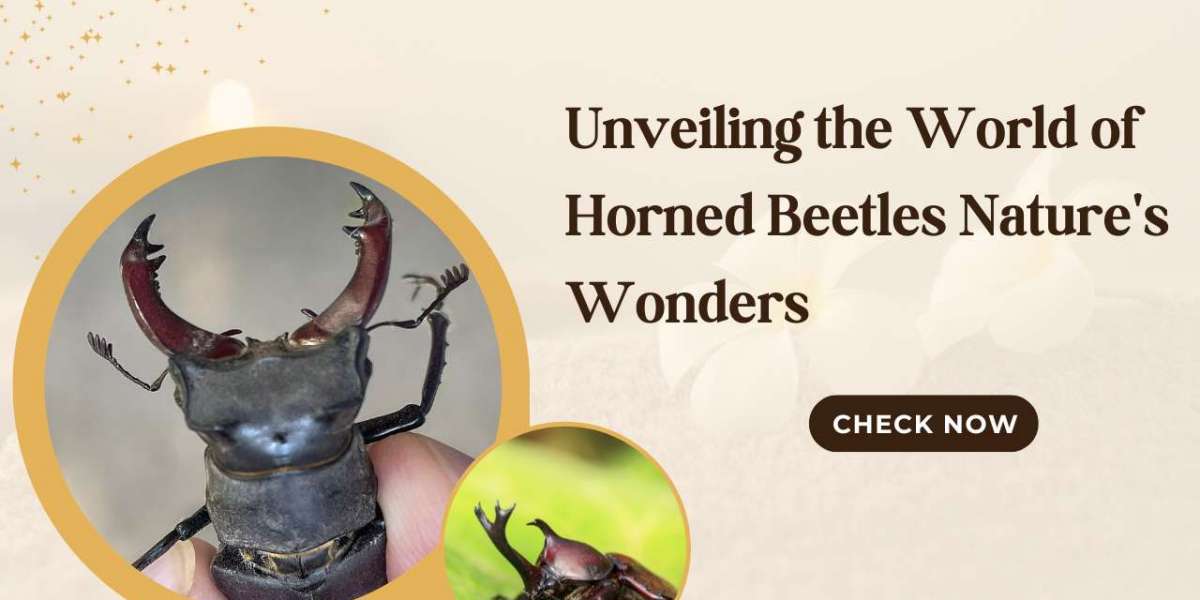Horned beetles are among the most fascinating and visually striking insects in the animal kingdom. Their distinctive horns and armored bodies make them a subject of intrigue for scientists, entomologists, and nature enthusiasts alike. This blog explores the captivating world of horned beetles, delving into their unique characteristics, species diversity, ecological significance, and their role in human culture.
Understanding Horned Beetles
Horned beetles belong to the family Scarabaeidae, which includes some of the most remarkable beetles known for their impressive horns. These horns are not just for show; they play crucial roles in the beetles' survival and reproduction.
Physical Characteristics
Horned beetles are characterized by their robust bodies and the presence of one or more horns on their heads or thoraxes. These horns are typically used for defense, competition, and mating. The size and shape of the horns can vary significantly among species, and in some cases, between males and females of the same species.
Sexual Dimorphism
In many horned beetle species, males possess larger and more pronounced horns than females. This phenomenon, known as sexual dimorphism, is primarily driven by the need for males to compete for mates. The horns are used in combat with other males, helping to establish dominance and secure mating opportunities.
Diverse Species of Horned Beetles
There are thousands of species of horned beetles found across the globe, each with its own unique characteristics and ecological roles. Here are a few notable examples:
Rhinoceros Beetles
Rhinoceros beetles, belonging to the subfamily Dynastinae, are among the largest and most powerful beetles. Their name comes from the prominent horn on the males' heads, resembling a rhinoceros horn. These beetles are found in tropical and subtropical regions and are known for their incredible strength, capable of lifting objects many times their own weight.
Hercules Beetles
Hercules beetles (genus Dynastes) are famous for their enormous size and impressive horns. The males have long, curved horns that they use to fight for territory and mates. Hercules beetles are predominantly found in Central and South America, inhabiting rainforests and other lush environments.
Stag Beetles
Stag beetles (family Lucanidae) are easily recognizable by their large mandibles, which resemble the antlers of a stag. These beetles are primarily found in temperate regions, including North America, Europe, and Asia. Male stag beetles use their mandibles to wrestle each other in competitions for mates.
Atlas Beetles
Atlas beetles (Chalcosoma atlas) are native to Southeast Asia and are known for their striking horns. Males have three prominent horns: one on the head and two on the thorax. These beetles are strong fighters, using their horns to lift and throw rivals during battles for dominance.
Ecological Significance of Horned Beetles
Horned beetles play essential roles in their ecosystems. They contribute to nutrient cycling, soil aeration, and the decomposition of organic matter. Here are some ways in which these beetles impact their environments:
Decomposers
Many horned beetles, particularly those in the Scarabaeidae family, are decomposers. They feed on decaying plant material, animal dung, and other organic matter. By breaking down this material, they help recycle nutrients back into the soil, promoting plant growth and maintaining ecosystem health.
Soil Aeration
As horned beetles burrow into the ground to lay their eggs or seek shelter, they create tunnels that aerate the soil. This process improves soil structure, allowing air, water, and nutrients to penetrate deeper into the ground, benefiting plant roots.
Pollinators
Some horned beetles, such as the rhinoceros beetle, also act as pollinators. While searching for food or mates, they visit flowers and inadvertently transfer pollen from one flower to another, aiding in plant reproduction.
Horned Beetles in Human Culture
Horned beetles have captured the imagination of humans for centuries. They appear in folklore, art, and even as pets in various cultures.
Symbolism and Folklore
In many cultures, horned beetles symbolize strength, power, and resilience. Ancient Egyptians revered the scarab beetle as a symbol of rebirth and regeneration, often depicting it in their art and jewelry. Similarly, in some Asian cultures, rhinoceros beetles are considered symbols of good luck and prosperity.
Beetle Fighting
In parts of Southeast Asia, beetle fighting is a popular pastime. Male beetles, particularly rhinoceros and stag beetles, are pitted against each other in contests of strength. These events draw large crowds and are often accompanied by betting and festive celebrations.
Exotic Pets
Horned beetles are also kept as exotic pets by enthusiasts around the world. Their striking appearance and relatively easy care make them popular among insect hobbyists. Breeders and collectors often trade these beetles, contributing to the global interest in these fascinating creatures.
Conservation of Horned Beetles
Despite their ecological importance and cultural significance, many horned beetle species face threats from habitat loss, climate change, and human activities. Conservation efforts are crucial to protect these beetles and their habitats.
Habitat Preservation
Protecting the natural habitats of horned beetles is essential for their survival. This includes conserving forests, grasslands, and other ecosystems where these beetles thrive. Efforts to reduce deforestation and promote sustainable land use practices can help preserve these habitats.
Research and Education
Increased research on horned beetles can provide valuable insights into their biology, behavior, and ecological roles. Educating the public about the importance of these beetles can also foster appreciation and support for their conservation.
Breeding Programs
Captive breeding programs can help bolster populations of threatened horned beetle species. By breeding beetles in controlled environments and reintroducing them into the wild, conservationists can help maintain genetic diversity and increase population numbers.
Conclusion
Newman Art Design Horned beetles are a testament to the wonders of nature, showcasing incredible adaptations and playing vital roles in their ecosystems. From their striking horns to their ecological contributions, these beetles continue to captivate and inspire. As we learn more about these remarkable insects, it is essential to support conservation efforts to ensure that horned beetles remain a thriving part of our natural world. By preserving their habitats and raising awareness about their importance, we can help protect these fascinating creatures for future generations to admire and study.








